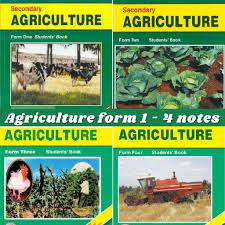- AGRICULTURE ECONOMICS (BASIC CONCEPTS AND FARM RECORDS)
This topic entails the following
- Definition of scarcity, tastes and preferences, opportunity cost as used in agricultural production.
- Uses of farm records
- Types of farm records i.e. production, field operation, breeding, feeding, health, labour and muster roll.
AGRICULTURAL ECONOMICS I
Economics: this is the study of how man and society choose with or without money to employ scarce resources to produce goods and services over a period of time and eventually distribute them for consumption now and in the future.
Agricultural economics: this is an applied science that aims at maximizing output while minimizing costs by combining the limited factors of production to produce goods and services for use by the society over a period of time.
Factors of production
- Land
- Capital
- Labour
- Management/entrepreneurship
Basic concepts of economics
These concepts include:
- Scarcity
- Preference and choice
- Opportunity cost
- Scarcity
Scarcity means limited in supply
The factors of production named above are scarce and the production needs are many therefore the need for choice
- Preference and choice
Since the factors of production are limited, the farmer needs to make a choice on what to produce. This choice has to be guided by the needs of the society and the preference of the farmer on what he needs to produce.
- Opportunity cost
When the farmer makes a choice on what to produce, he is forced to leave others due to scarcity of resources e.g. a piece of land is suitable for growing both rice and maize and he choose to grow maize, the value that could have been derived from rice becomes the opportunity cost.
Opportunity cost is the value of the best foregone alternative
Download more free unlimited Agriculture Resources Here:
AGRICULTURE SCHEMES OF WORK FORM ONE TO FOUR: UPDATED
Agriculture notes free pdf download (Form 1-4)
AGRICULTURE REVISION QUESTIONS AND ANSWERS F1-4
Agriculture KCSE Topical Questions and Answers Form 1-4 (All subjects)
FORM ONE FREE AGRICULTURE NOTES
AGRICULTURE KCSE REVISION BOOKLET: F1-4 QUESTIONS (EXAMS) AND ANSWERS

FARM RECORDS
Farm records can be defined as the systemic entries and storage of information of various farm business activities and transactions in appropriate books and sheets.
Uses of farm records
- Helps to compare the performance of different enterprises within a farm
- Show the history of the farm
- Guides a farmer in planning and budgeting of farm operations
- Help to detect loss or theft on the farm
- Help in the assessment of income tax to avoid over or under taxation
- Helps to determine the value of the farm or to determine the assets and liabilities of the farm
- Make it easy to share the profits and losses in partnership
- Helps in settling dispute among heirs to the estate when a farmer dies without leaving a will
- Help to show whether a farm business is making profits or loses
- Helps in supporting insurance claims on death, theft etc
- Provide labour information like terminal benefits e.g. NSSF
Types of farm records
- Production records
- Inventory records
- Field operation records
- Breeding records
- Feeding records
- Marketing records
- Labour records
- Inventory records
This is the physical count of everything that the farm owns and all that it owes others. There are two types of inventory records namely:
- Consumable goods inventory
- Permanent goods inventory
- a) Consumable goods inventory
This is inventory showing a list of goods which normally are used up during a production process, therefore needs constant replacement. Such goods include:
- Fertilizers
- Livestock feeds
- Planting materials e.g. seeds
- Chemicals e.g. insecticides, herbicides
- Sisal ropes and strings etc
Example of consumable goods inventory
| RECIEPTS | ISSUES | |||||
| DATE | ITEM | QUANTITY | DATE | ISSUED TO | QUANTITY | BALANCE IN STORE |
- b) Permanent goods inventory
This is inventory showing a list of goods which are permanent in nature ie the type of goods which will not get used up in the production process such goods include:
- Farm machinery and implements
- Farm equipment and buildings
- Livestock such as breeding stock
- Annual crops
- Hand tools
- Land (arable)
Example of permanent goods inventory
| DATE | ITEM | QUANTITY | WRITTEN OFF | BALANCE IN STOCK | REMARKS |
- Production records
This is a record which show the total yield from each enterprise and also the yield per unit of the enterprise.
Example of production records (dairy milk production record)
Month…………………………………………………………year……………………………………………………
| Name or no. of cow | Days of the month | ||||||||||||||
| 1 | 2 | 3 | 4 | 31st day | TOTAL | ||||||||||
| 5AM | 5PM | 5AM | 5PM | 5AM | 5PM | 5AM | 5PM | ||||||||
| BETA | |||||||||||||||
| ZABAH | |||||||||||||||
| MOON | |||||||||||||||
| TOTAL | |||||||||||||||
Example of production record ( crop)
Plot/field No. 15
| CROP | SIZE OF FARM | SEED RATE | DATE OF PLANTING | DATE OF HARVESTING | YIELD IN BAGS |
- Field operation records
This record contains all the activities carried out in the production from land preparation, planting to harvesting. It contains the following information:
- Date of land preparation
- The size of field
- Crop variety planted
- Type and amount of fertilizer applied
- Seed rate
Example of field operation record
|
- Breeding records
These are records showing the breeding activities and programmes for different animals in the farm.
Importance of breeding records
- Help the farmer to plan his breeding programmes
- Help in selection of animals within a herd
Example of cattle breeding record
| Name/No. of cow | Name of bull/sire | Date of service | Date of pregnancy diagnosis | Expected date of calving | Actual date of calving | Sex of calf | Wt. of calf | Rmks |
N/B: students to draw sheep, pig, and sow breeding records
- Feeding records
This is a record showing the type and amount of feeds used in the farm.
Example of feeding records
| Month:……………………………………….
Enterprise………………………………….. Type of feed……………………………….
|
|||||
| Date | No. of animals | Amount received (kg) | Amount used (kg) | Balance in stock (kg) | remarks |







